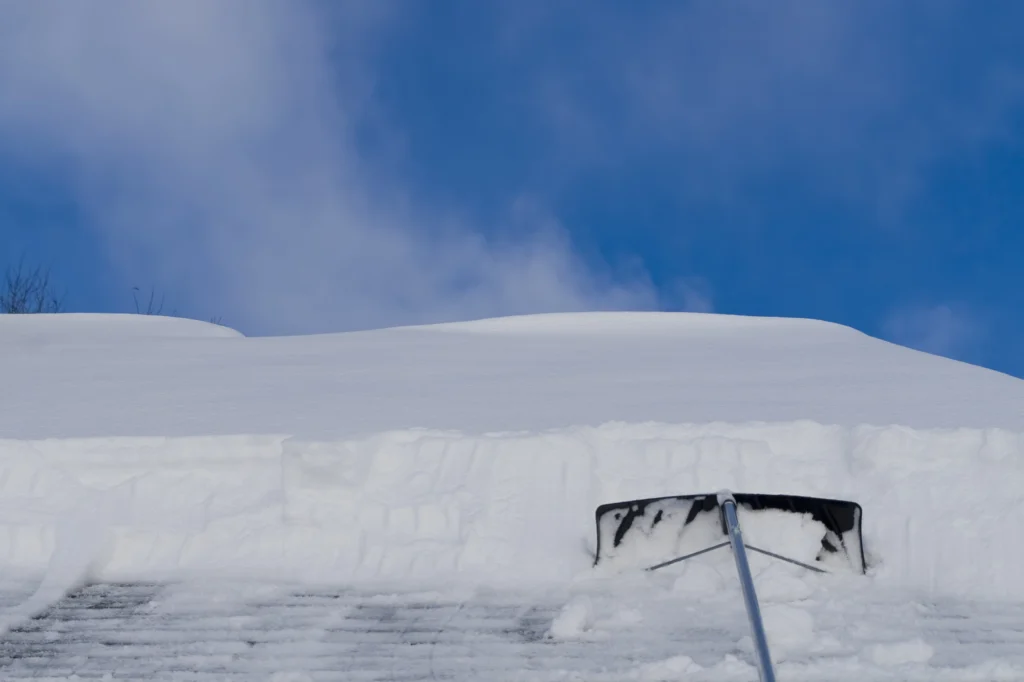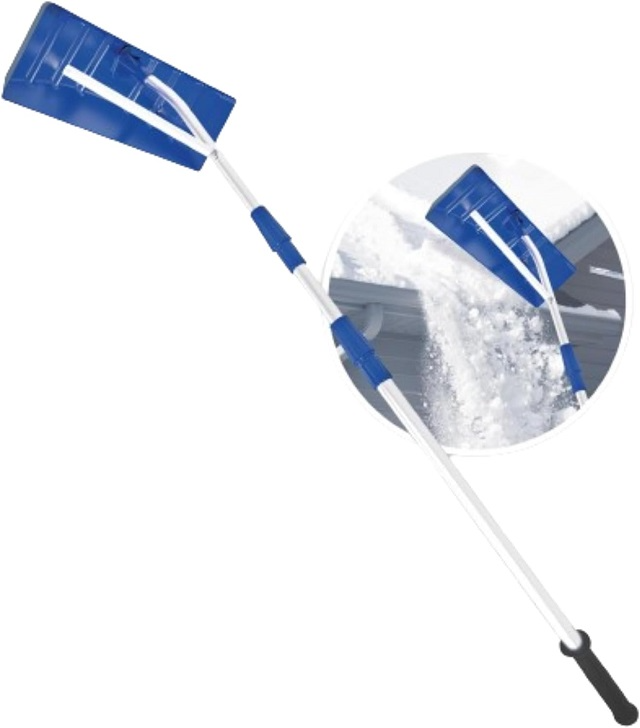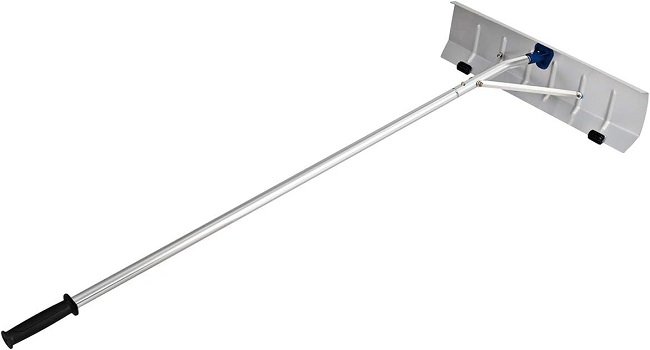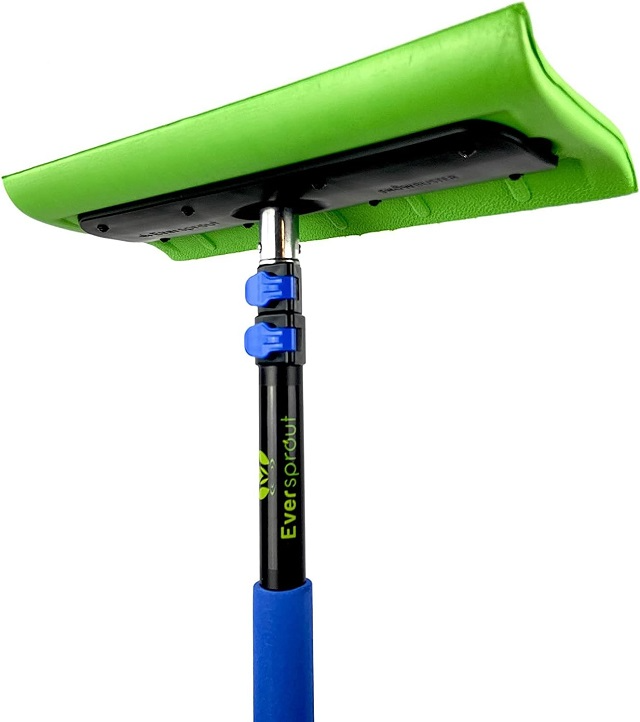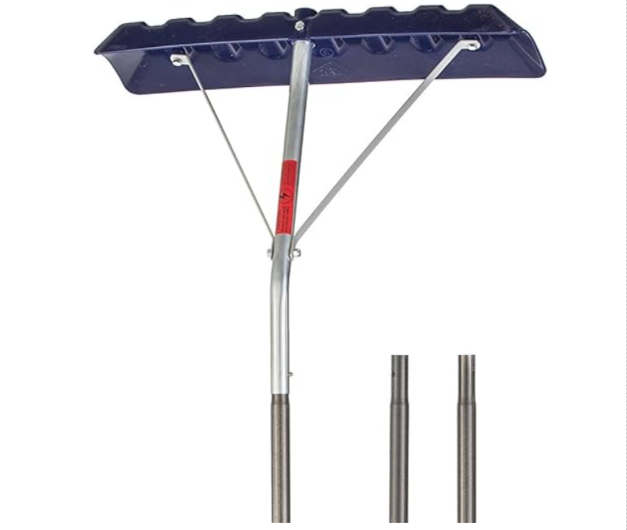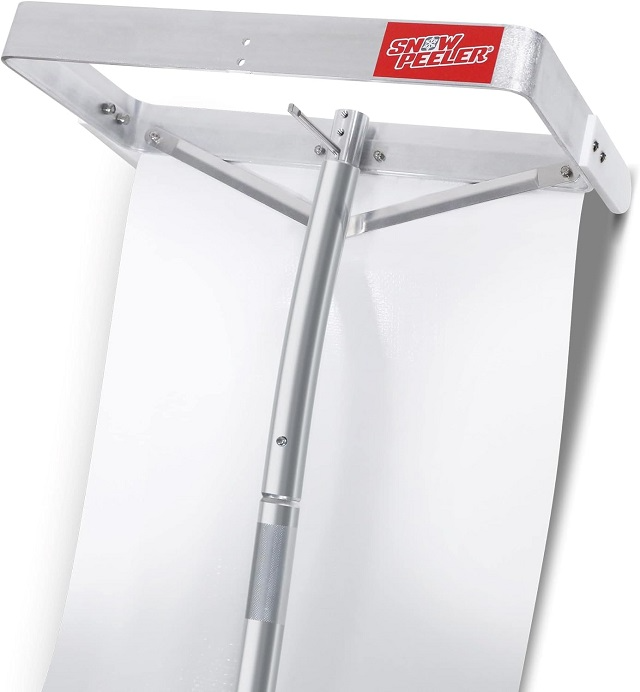Heavy snow, slush, and ice are normal parts of New England winter weather, and protecting your roof is an essential part of owning a home. Given the large amount of weight snow can place on your roof, removing it is imperative to preventing structural damage to your house.
Getting up on your roof to shovel snow is not recommended due to the danger and risk of injury. But a roof rake for snow is a specialized tools designed to remove snow from a roof while you’re still standing safely on the ground.
Similar to roof shovels for now, the best roof rake for snow features a long handle with a wide blade on the end. This allows you to safely pull snow off your roof, which can help prevent ice dam formation and potential structural damage from the excess weight.
Various types of roof rakes for snow are available, including some with an adjustable handle for reaching multiple heights, wheels for easily gliding the rake along the roof, and a non-metallic blade to protect your shingles. Consider these features, as well as the height and pitch of your roof, when choosing which roof rake to get.
The Snow Joe 21′ Twist-n-Lock Telescoping Snow Roof Rake is a top choice for a roof rake for snow removal. As the name implies, this roof rake features an adjustable handle that twists and locks into place to keep it secure while in use. Additionally, the rake has an extra-wide blade to scrape snow off your roof effectively.
In this article:
- Types of Roof Rakes for Snow
- How to Use a Roof Rake to Remove Snow From Your Roof
- Safety Precautions and Risks
- Best Roof Rakes for Snow
- Frequently Asked Questions
Roof Rake for Snow Types
| Type of Roof Rake for Snow | Key Features |
| Roof Rake with Blade | A wide, flat end to scrape snow off a roof Blades made of plastic, aluminum, or foam Some have wheels, rollers, or slides |
| Scoop-Style Roof Rake | A wide scoop instead of a flat blade at the end Made of lightweight materials for easy handling Some have telescoping handles More efficient than a flat-blade roof rake, so fewer passes may be needed to clear a roof |
| Telescoping Roof Rake | Extendable handle Ergonomic handles or grips for more comfortable use More compact for storage |
| Sliding Roof Rake | Flat bladed roof rake for snow Extended sheet or chute to help snow slide off the roof Effective for sloped roofs Avoids damage to shingles Less physically demanding to use compared to other types |
| Heavy-Duty Roof Rake | Designed for bigger jobs Made of reinforced aluminum, heavy-duty plastic, or steel Wide blade head Some have a sheet slide or wheels Heavier than other types of roof rakes |
Roof rakes are designed with the same goal in mind: to pull snow off the roof via a long handle and blade or scoop. However, there are several types of roof rakes to choose from to suit your needs. Roof rakes for snow include:
Roof Rake with Blade
A roof rake for snow removal should feature a wide, flat end to effectively scrape the snow off the roof. Some roof rakes feature blades made from plastic, aluminum, or foam to slice through the snow as you drag it off the edge.
These roof rakes typically have long, adjustable handles, making it easier to reach higher parts of your roof from the ground. Some models are outfitted with wheels, rollers, or slides to move easily along your roof without damaging shingles.
Scoop-Style Roof Rake
Some roof rake models feature a wide scoop at the end instead of a flat blade. They’re typically made of lightweight materials like durable plastic or aluminum, so they’re easy to handle and maneuver.
The curved blade gathers and pulls snow off the roof more effectively than a flat-blade roof rake, reducing the number of passes needed and making the task less physically demanding. Some scoop-style roof rakes have telescoping handles to reach higher parts of your roof without a ladder, and the scoop-style blade is typically designed to be gentle on roofing materials, reducing the risk of damaging your shingles.
Telescoping Roof Rake
A telescoping roof rake for snow features a handle that can extend to reach higher parts of the roof. These roof rakes often have ergonomic handles or grips, making them more comfortable to use, even for long periods.
Many other types of roof rakes come with telescoping handles, so you don’t have to climb onto your roof to effectively remove snow and ice. Telescoping handles not only allow you to adjust the length of a roof rake but also make it more compact for storage when it’s not in use.
Sliding Roof Rake
A sliding roof rake features a flat blade attached to an extended sheet or chute, usually made of aluminum or durable woven fabric. As the blade cuts through the snow, it slides down the chute and off the roof. This design requires less effort compared to traditional roof rakes, utilizing gravity to remove the snow instead of manually pulling it down and over the roof’s edge.
With a sliding roof rake, it’s best to begin by clearing the edges of your roof. This gives you cleared space to properly position the chute to clear the upper sections of the roof more easily. This type of roof rake is effective for sloped roofs and prevents damage to shingles.
Heavy-Duty Roof Rake
A heavy-duty roof rake for snow is designed for bigger jobs. These rakes often have wider blade heads made of reinforced aluminum, steel, or heavy-duty plastic to resist wear and tear. Some heavy-duty roof rakes have a sheet slide or wheels to make it easier to remove larger amounts of snow off your roof while also minimizing the risk of damaging your shingles.
The handle is usually long and can be extended, allowing you to reach high or large roof areas from the ground. It’s often reinforced to prevent bending under the weight of heavy snow. Due to the weight of the materials, heavy-duty roof rakes for snow are heavier than other types of roof rakes for snow and can be more difficult to maneuver.
Using a Roof Rake to Remove Snow From Your Roof
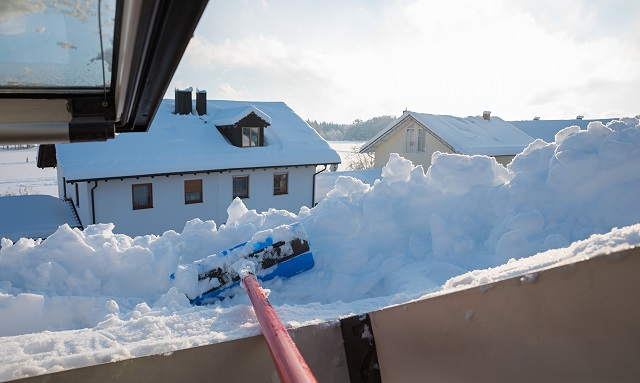
Massachusetts gets an average of 47 inches of snow per year, compared to the national average of 28 inches. Typically, there are a few times each year when snowfall accumulation reaches 10 inches or more in some areas of the state.
That means Massachusetts homeowners are faced with the task of removing snow from their roofs more often than in many other parts of the U.S.
The beauty of a roof rake for snow removal is that you get to stay on the ground, which minimizes the dangers and risks of walking on a snowy or icy roof. For the most part, using a roof rake is self-explanatory, but keep the following in mind:
- Determine if snow removal is necessary: Roofs can typically support 25 to 30 pounds per square foot, with snow weighing about 20 pounds per cubic foot. Generally, you should remove snow from your roof once it accumulates 12 inches or more. However, if there’s already 8 to 10 inches of snow and several more inches are expected, it’s easier and safer to remove smaller amounts of snow at a time rather than waiting to remove a foot or more all at once.
- Inspect your roof: Inspect your roof to make sure it’s in decent condition so you know what you’re up against. You want to avoid pulling off loose shingles or gutters while removing the snow from your roof.
- Choose the right roof rake for the job: When it comes to a roof rake for snow, there are various types to choose from, each with its own attributes and benefits. All roof rakes have a long handle and wide base that allow you to push or pull snow off single-story roofs without the need for a ladder. Some roof rakes have an adjustable handle so you can reach various heights. The base of the rake can be a flat blade, scoop, or foam. Blades and scoops are either made from aluminum or plastic.
- Begin at the edge of your roof: Start pulling snow off your roof from the edge and work your way up as high as the rake will reach. You want to reduce the depth of snow to alleviate the weight but should leave about two or three inches to protect your roof, rather than scraping it down to the shingles and risking damage.
- Go slow: Don’t rush the process. Go slow as you pull snow off your roof. Don’t press too hard or over-exert yourself.
- Watch out for ice and falling snow: Just because you’re standing on the ground instead of up on your roof doesn’t mean there isn’t risk involved. Keep an eye out for falling icicles or chunks of hard snow as you drag snow off the roof. Consider your landscaping below, as well.
- Be careful of overhead obstacles: Be careful of surrounding obstacles, like power lines, low-hanging tree branches, or your home’s gutters. Avoid climbing onto the roof or using a ladder, and attempt to reach as much of the roof as possible from the ground.
Safety Precautions and Risks
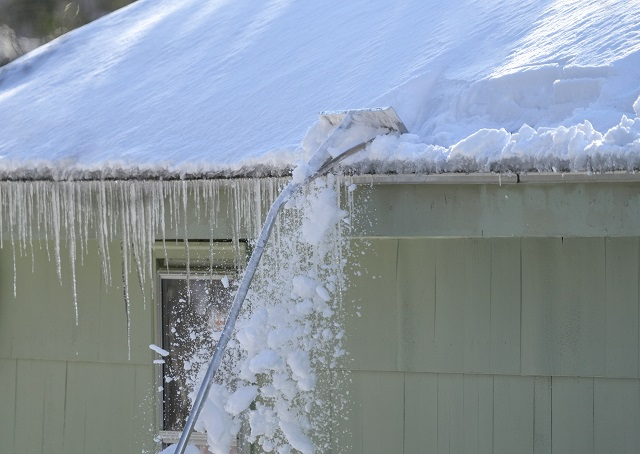
When using a roof rake for snow and planning your snow removal efforts, take safety precautions and be aware of risks to prevent damage to your roof and injury to yourself.
Safety Precautions
Some steps you can take to remain safe include:
- Use the right equipment: As previously stated, choosing the right roof rake ensures that removing snow from your roof is easy and safe. The right roof rake is meant to help you reach the snow without having to climb onto the roof.
- Don’t do it alone. Dangerous home maintenance tasks like removing snow from your roof should always be done with at least one other person. A person observing from a safe distance can watch out for your safety, and if there’s an accident or emergency, they can quickly get help.
- Wear protective gear: Not only should you bundle up if it’s cold outside, but you should wear protective gear to help avoid injury. Wear non-slip boots to stand sturdy and well-fitted gloves so you can properly hold onto the handle of the rake. Consider a hard hat or protective eyewear in case of falling ice or snow.
- Clear snow strategically: Don’t stand right underneath where you’re clearing snow from. Begin at the edge of your roof and sweep the snow down and away from you.
- Call a professional: If you’re unsure about clearing the snow yourself, call a professional roofer to do it for you.
Risks
Consider the risk involved with removing snow from the roof, and don’t be afraid to call a roofing professional to handle it for you. Some risks include:
- Falling or slipping: Though you don’t need to climb onto a snow-covered or slippery roof to use a roof rake, working in snowy conditions comes with a risk of falling or slipping regardless.
- Damage to shingles: If you choose the wrong roof rake or use an incorrect method you could damage the shingles on your roof, which may lead to leaks and other issues.
- Ice dams: Ice dams may cause water to back up under your shingles, resulting in leaks and water damage inside your home. If you’re unable to eliminate ice dams, consider hiring a professional roofer to do the job.
- Bodily injury: A metal roof rake should not be used near power lines, as this can increase the risk of electrocution. Removing snow from your roof is physically demanding. Take breaks as needed to avoid excessive muscle strain.
Best Roof Rakes for Snow
Best Overall Roof Rake for Snow: Snow Joe 21′ Twist-n-Lock Telescoping Snow Roof Rake
The Snow Joe 21′ Twist-n-Lock Telescoping Snow Roof Rake is the best overall choice for roof rake for snow removal because it’s easy to use and gentle on your roof. It’s designed to clear large amounts of snow with its 25-inch wide and 6-inch long blade head, giving you maximum effectiveness with each pass. The oversized blade head is made from poly plastic, which is safe and gentle for your roof and limits the risk of damaging shingles.
Featuring an innovative twist-and-lock telescoping pole, this roof rake extends from 6 feet to 21 feet and provides a total of 27 feet of overhead reach, depending on your personal height. This allows you to stand firmly on solid ground while safely removing snow from your roof.
The Snow Joe Telescoping Snow Roof Rake has an aluminum handle with a rubberized grip, making it easy to handle and maneuver. Plus, because it’s manufactured from plastic and aluminum, it’s lightweight, weighing just under 5 pounds.
Best Budget Roof Rake for Snow: Gymax Snow Roof Rake
The best budget roof rake for snow is the Gymax Snow Roof Rake. At an affordable price, it can help clear snow from your roof without needing to climb a ladder or get up on your roof. Not only does it fit in the budget, but it’s easy to use and gets the job done with its extra-wide blade, which measures 6.5 inches long by 26 inches wide.
Though the Gymax rake has an aluminum blade head, it’s outfitted with snowflake rollers so it glides easily over your roof as you remove snow. The rollers provide a gap between the blade and the roof, which allows for a scratch-free sweep across the roof, helping to minimize damage to shingles.
The Gymax roof rake has an adjustable handle that features five sections, allowing you to create a handle from 5 feet to 20 feet so you can reach multiple heights on your roof. Made from aluminum, the rake is lightweight at about 5 pounds, so it’s easy to manipulate. Plus, the tip of the handle has a grip made out of TPE, or thermoplastic elastomer.
Most Gentle Roof Rake for Snow: Eversprout Never-Scratch SnowBuster
As one of the most gentle roof rake for snow removal, the Eversprout Never-Scratch SnowBuster is popular for use on all types of roofs, even those with solar panels, due to the soft foam padded blade head. With an S-shape design that measures 16 inches wide and 6.5 inches long, this roof rake is made so you can push or pull fresh snow off the roof easily without causing any damage.
The Eversprout roof rake extends from 5 feet to 12 feet, with a total overhead reach of about 18 feet, depending on your personal height. It features a flip-tab locking mechanism to keep the pole sturdy while in use. The pole is made from aluminum, features non-slip hand grips, is easy to handle, and is one of the lightest roof rakes, weighing only 1.5 pounds.
As a bonus, the Eversprout SnowBuster comes with a 1-year warranty, and a tree is planted with every order.
Best Lightweight Roof Rake for Snow: Garant Yukon Snow Roof Rake
The Garant Yukon Snow Roof Rake weighs about 4 pounds and is one of the best lightweight roof rakes that’s made from aluminum. The wide blade head is made from polyethylene, so it’s sturdy, easy to use, and won’t damage your roof. At 24 inches wide, the Garant Yukon Snow Roof Rake can move a large amount of snow off your roof in one sweep.
This roof rake for snow comes in three sections of 5-foot poles, which are easy to assemble, so you can reach your roof without issue. The poles are designed with anti-slip grips that are easy to hold on to.
Best Telescoping Roof Rake for Snow: SnowPeeler Premium Roof Rake
The SnowPeeler Premium Roof Rake is the best telescoping roof rake for snow because it extends up to 30 feet, allowing you to clear snow from your roof from great heights. It also provides a reach up to 25 feet horizontally, so you can do the job while standing firmly on the ground.
This roof rake for snow removal features a 9-foot tear-resistant slide or chute attached to the aluminum blade head for heavy-duty action, making it more efficient at clearing snow from your roof. The slide moves larger amounts of snow faster than traditional roof rakes.
The SnowPeeler roof rake with slide is effective and easy to maneuver. It works in both fresh and packed snow. The end of the rake is outfitted with glide pads that help protect your roof and shingles from damage by preventing the rake from scraping the roof too closely.
Frequently Asked Questions
What is a roof rake?
A roof rake is made to remove snow from your roof without you having to step foot on your roof. This safer alternative features a long handle with a wide blade at the end so you can stay on the ground and carefully pull snow off the edge of the roof. The rake is designed to scrape over your shingles and is slightly angled so it slides under the snow effectively.
Is it safe to shovel your roof?
It can be safe to shovel snow off your roof if you do it correctly. Your best option is to use a roof rake to safely and effectively remove snow from your roof. Consider the following:
- Use the right equipment: A specially designed roof rake for snow removal can help you reach the snow without climbing onto the roof.
- Wear protective gear: Wear proper winter attire for grip and warmth.
- Start at the roof’s edge: Pull snow from the edges and work your way toward the middle of the roof. This method reduces the weight of the snow and minimizes the risk of damage.
- Be careful of obstacles: Be aware of obstacles such as power lines, vents, low-hanging tree branches, and gutters.
Does removing snow from your roof damage the shingles?
Removing snow from your roof could potentially damage your shingles if it’s not done correctly. To help minimize the risk of damage, consider hiring a professional to do it for you.
Steps you can take to avoid damaging your roof include using the right tool to remove snow safely and effectively and leaving a couple of inches on your roof to protect the shingles. Additionally, take your time clearing the snow off your roof to ensure your own safety.
What is the best way to remove snow from your roof?
The best way to remove snow from your roof is to use a roof rake with a long handle and wide base. Find a stable place to stand on the ground and begin at the roof’s edge. Carefully pull snow off the roof—while being mindful of obstacles—and avoid scraping the shingles directly.
Try to leave a couple of inches of snow, which will help protect your roof. If you’re unsure about removing snow from your roof or if it’s too difficult, it may be best to hire a professional roofing contractor to do it for you.
Can I use a regular shovel to remove snow from the roof?
It’s not recommended to use a regular shovel to remove snow from your roof. The sharp metal edge could dig into your shingles and cause damage to your roof. This is why you should exclusively use a roof rake for snow.
It’s also not recommended to climb onto a snowy roof, as it can be hazardous due to slippery conditions. A roof rake is the best tool for safely removing snow from your roof.

